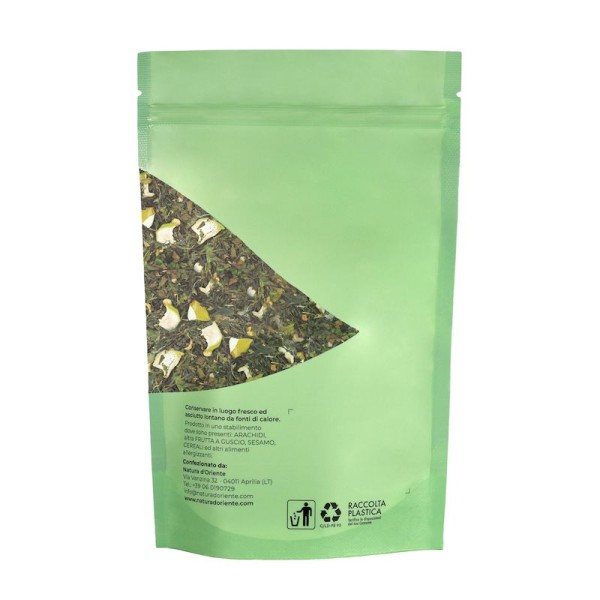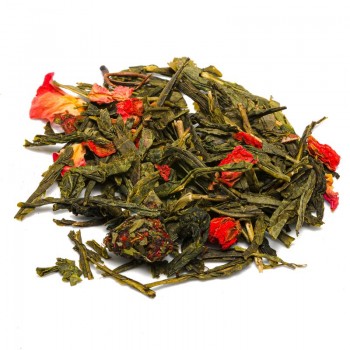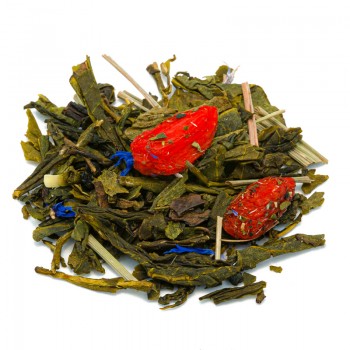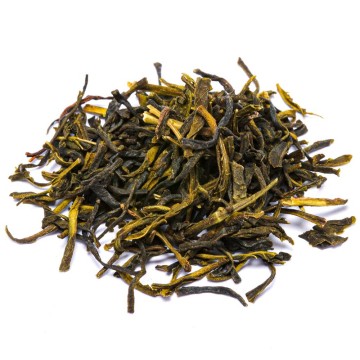Apple and ginger green tea
A top quality tea, Sencha green tea, is combined with beneficial apple and ginger slices, for a spicy and pleasantly sweet drink. It is a perfect drink both in winter, warm and enveloping with scents, and cold in summer as a refresher.
Apple and ginger green tea surprises with its spicy sweetness. The pieces of apple sweeten the blend, balancing the more bitter notes of Sencha tea (a balance between sweet, bitter and astringent taste). Ginger inserts pungent energy spikes. Gives spicy and sweet notes at the same time, hydrates and satisfies the senses being a full-bodied and relaxing tea. All ingredients are valued for their taste and potential wellness benefits.
Properties and benefits
In this apple and ginger green tea there are several beneficial elements, especially at the digestive level. Ginger and apple promote the assimilation of food, making the tea ideal to combine with meals. They are detox ingredients useful for purifying yourself, recovering energy especially after a large meal. Ginger, in particular, has been shown to possess qualities suitable for stimulating the correct digestive phase, which are combined with those of green tea. Ginger root is famous in herbal medicine for naturally treating stomach irritations, nausea, acid reflux – thanks to its alkalizing effect on the body.
The main active component of ginger is called 6-gingerol which gives the spicy flavour. It is known for its numerous biological properties, from antioxidants to anti-irritation activities. Green tea is known for normalizing intestinal function but also for being rich in antioxidants - elements that reduce the amount of free radicals in the body. It therefore favors the contrast to the aging process and cellular damage caused by free radicals. The antioxidants of ginger and apple also combine with the properties of tea.
The latter improves our intestinal transit, purifying the intestine of toxins, helping it to better absorb the nutrients. Furthermore, green tea helps the body burn fat by stimulating the metabolism. By combining the properties of ginger and apple, a healthy drink is created for those who want to lose weight. By combining an adequate diet for weight loss, apple and ginger green tea provides some valid components. Apples provide satiating fibers, tea has a diuretic and purifying effect, while ginger increases fat-burning properties thanks to natural compounds such as shogaols and gingerols.
In the ancient Chinese herbal tradition , green tea is known for draining body fluids and maintaining body weight in balance, as well as a tonic and antioxidant. In fact, green tea displays antioxidants with numerous biological activities, the polyphenols EGCG, EGC, ECG and EC, and flavonoids which help the thermogenesis effect (fat-burning) and cardiovascular well-being. Furthermore, apple and ginger tea also has relaxing effects, with its aroma and decongestant action for the respiratory tract. The apple can counteract irritation to the respiratory system, thanks to the presence of flavonoids and pectin in the fruit.
Origins and History of cultivation
Green tea comes from the Camellia sinensis plant which grows in the mountainous areas of China, India and other countries. To make green tea, fresh leaves are quickly steamed to stop oxidation, a chemical process that causes browning. Sencha tea is famous, according to the typical Japanese process, and the most widespread in Japan. The tea is grown in direct sunlight, and the leaves are harvested twice a year.
Sencha is created by boiling and then drying. Green tea has been used medicinally in China and Japan for thousands of years, as a plant known to treat various ailments, mainly digestive and as a natural anti-inflammatory. Ginger is a tropical flowering plant, which displays a fragrant root and is highly appreciated for food use. It is a plant native to Southeast Asia. The root is distinguished by its brown and knotty appearance, and is usually peeled and grated, for a spicy touch to many dishes. In its dried form, it is used to flavor baked goods or for tea infusions.
The apple comes from the apple tree, one of the first to be cultivated by man. Already present in the Neolithic period, the apple tree comes from the territory of Central Asia. Over the centuries it spread'tree in the Middle East, cultivated along the Nile valley in Egypt and, later, on the Greek and Mediterranean territory. The apple tree is the most cultivated tree in the world, and in the many varieties it gives different fruits. Apples are among the most popular fruits, also because they are easily transportable thanks to their good preservation qualities when travelling.
Plant and flowers
Camellia sinensis is an evergreen shrub grown to produce tea, obtained from the leaves. Two main varieties of the plant are recognized: Camellia sinensis var. sinensis (Chinese tea) and C. sinensis var. assamica (Assam tea, Indian tea). It is a very long-lived plant, which requires care including soil preparation, shading and pruning.
It could reach about 9 meters but is pruned to facilitate the hand-picking of the leaves. It prefers moist but well-drained soils, where planting is done in autumn and winter, avoiding the monsoons. It displays a white, fragrant flower that blooms from autumn to early winter. The Malus domestica plant is a tree of the Rosaceae family. The tree develops best in temperate climates, where there is a winter period distinct from the other seasons. The soil must be well drained, preferably hilly - to allow cold, heavy air to flow into the valley. The apple has a variable color between red, green or yellow, based on the cultivated varieties, as well as the size, shape and acidity.
Nutritional values of green tea apple and ginger
The components of this tea are mainly antioxidants and nutritional substances, such as the amino acids theanine and arginine. It makes available ascorbic acid (vitamin C), vitamin B, caffeic, chlorogenic, and malic acids, as well as alkaloids such as caffeine and theobromine. Contains polyphenols such as antioxidant catechins (epigallocatechin-3-gallate EGCG, epigallocatechin EGC, epicatechin EC), and mineral salts (calcium, copper, iron, magnesium, phosphorus, potassium). Apple wedges provide vitamins, fibers and proteins, making substances such as malic acid, pantothenic acid, lutein and zeaxanthin available. Ginger provides the compounds gingerols and shogaols, studied for their potential benefits on the body.
How to prepare Apple and Ginger Green Tea
The infusion is obtained by placing about 3-5 grams of the apple and ginger green tea mixture in a cup (250 ml). Water at a temperature of 80 °C. Leave to infuse for 2 to 3 minutes, before drinking the green tea infusion.
Apple and ginger green tea: side effects and contraindications
Green tea, when consumed as a beverage, is believed to be safe when used in moderate amounts. It should be remembered, however, that green tea and green tea extracts contain considerable amounts of caffeine. For this reason, it is advisable not to exceed the consumption of tea, avoiding that the theine / caffeine contained can cause undesirable effects.
Excessive caffeine intake can cause agitation, nervousness, anxiety, stomach problems, rapid heartbeat, headache. Furthermore, green tea contains catechins which, in large quantities, could reduce the ability to absorb iron from food; for those suffering from iron deficiency it is good to pay attention to the excessive intake of green tea. Ginger root is generally thought to be safe to consume. Mild side effects may include abdominal discomfort, heartburn, diarrhea and intestinal gas. Caution is also advised for pregnant and breastfeeding women.









 No reward points for this product.
No reward points for this product.



![green tea hemp mango [Natura d'Oriente]](https://www.naturadoriente.com/3381-home_default/green-tea-mango.jpg)

![Green tea Jasmine and jasmine [Natura d'Oriente]](https://www.naturadoriente.com/3373-home_default/green-tea-jasmine-and-jasmine-.jpg)
![Green Tea Choui Fong Tea [Natura d'Oriente]](https://www.naturadoriente.com/3379-home_default/green-tea-choui-fong-tea.jpg)








